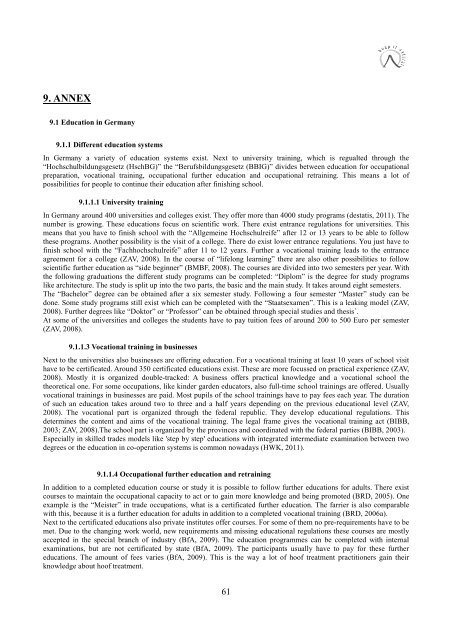Bachelor Thesis - Christina Kuenen - Hufpfleger
Bachelor Thesis - Christina Kuenen - Hufpfleger
Bachelor Thesis - Christina Kuenen - Hufpfleger
You also want an ePaper? Increase the reach of your titles
YUMPU automatically turns print PDFs into web optimized ePapers that Google loves.
9. ANNEX<br />
9.1 Education in Germany<br />
9.1.1 Different education systems<br />
In Germany a variety of education systems exist. Next to university training, which is regualted through the<br />
“Hochschulbildungsgesetz (HschBG)” the “Berufsbildungsgesetz (BBIG)” divides between education for occupational<br />
preparation, vocational training, occupational further education and occupational retraining. This means a lot of<br />
possibilities for people to continue their education after finishing school.<br />
9.1.1.1 University training<br />
In Germany around 400 universities and colleges exist. They offer more than 4000 study programs (destatis, 2011). The<br />
number is growing. These educations focus on scientific work. There exist entrance regulations for universities. This<br />
means that you have to finish school with the “Allgemeine Hochschulreife” after 12 or 13 years to be able to follow<br />
these programs. Another possibility is the visit of a college. There do exist lower entrance regulations. You just have to<br />
finish school with the “Fachhochschulreife” after 11 to 12 years. Further a vocational training leads to the entrance<br />
agreement for a college (ZAV, 2008). In the course of “lifelong learning” there are also other possibilities to follow<br />
scientific further education as “side beginner” (BMBF, 2008). The courses are divided into two semesters per year. With<br />
the following graduations the different study programs can be completed: “Diplom” is the degree for study programs<br />
like architecture. The study is split up into the two parts, the basic and the main study. It takes around eight semesters.<br />
The “<strong>Bachelor</strong>” degree can be obtained after a six semester study. Following a four semester “Master” study can be<br />
done. Some study programs still exist which can be completed with the “Staatsexamen”. This is a leaking model (ZAV,<br />
2008). Further degrees like “Doktor” or “Professor” can be obtained through special studies and thesis`.<br />
At some of the universities and colleges the students have to pay tuition fees of around 200 to 500 Euro per semester<br />
(ZAV, 2008).<br />
9.1.1.3 Vocational training in businesses<br />
Next to the universities also businesses are offering education. For a vocational training at least 10 years of school visit<br />
have to be certificated. Around 350 certificated educations exist. These are more focussed on practical experience (ZAV,<br />
2008). Mostly it is organized double-tracked: A business offers practical knowledge and a vocational school the<br />
theoretical one. For some occupations, like kinder garden educators, also full-time school trainings are offered. Usually<br />
vocational trainings in businesses are paid. Most pupils of the school trainings have to pay fees each year. The duration<br />
of such an education takes around two to three and a half years depending on the previous educational level (ZAV,<br />
2008). The vocational part is organized through the federal republic. They develop educational regulations. This<br />
determines the content and aims of the vocational training. The legal frame gives the vocational training act (BIBB,<br />
2003; ZAV, 2008).The school part is organized by the provinces and coordinated with the federal parties (BIBB, 2003).<br />
Especially in skilled trades models like 'step by step' educations with integrated intermediate examination between two<br />
degrees or the education in co-operation systems is common nowadays (HWK, 2011).<br />
9.1.1.4 Occupational further education and retraining<br />
In addition to a completed education course or study it is possible to follow further educations for adults. There exist<br />
courses to maintain the occupational capacity to act or to gain more knowledge and being promoted (BRD, 2005). One<br />
example is the “Meister” in trade occupations, what is a certificated further education. The farrier is also comparable<br />
with this, because it is a further education for adults in addition to a completed vocational training (BRD, 2006a).<br />
Next to the certificated educations also private institutes offer courses. For some of them no pre-requirements have to be<br />
met. Due to the changing work world, new requirements and missing educational regulations these courses are mostly<br />
accepted in the special branch of industry (BfA, 2009). The education programmes can be completed with internal<br />
examinations, but are not certificated by state (BfA, 2009). The participants usually have to pay for these further<br />
educations. The amount of fees varies (BfA, 2009). This is the way a lot of hoof treatment practitioners gain their<br />
knowledge about hoof treatment.<br />
61


